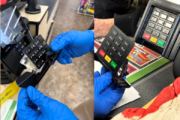WASHINGTON — Visitors to the re-opened National Air and Space Museum got an added treat today: a chance to meet an actual bionic man.
His name is Frank, short for Frankenstein, and although he doesn’t run, jump or fight, Frank does sport bionic body parts and implantable synthetic organs.
“The ultimate goal is not to replace the human being,” says Dr. Bertolt Meyer, a social psychologist at the University of Zurich, who has a bionic hand himself. “The ultimate goal is to provide technology to fix a broken person.”
Meyer served as the human model for Frank, which was made in a London warehouse by a team of engineers. They built Frank using 28 of the most advanced artificial body parts available today from laboratories and research centers around the world – combined for the first time to create a single, fully-functioning human-like replica, according to the Smithsonian.
Frank can walk slowly and answers questions with the help of a human using a laptop (provided those questions are supplied ahead of time).
And, when he does talk, it turns out he has a sense of humor. On the topic of the just-ended government shutdown, Frank says, “When we machines take over the world, I can assure you that all museums will remain open and all bills will be paid on time.”
␎
Dr. Bertolt Meyer, who has a bionic hand himself, talks about the capabilities and the usefulness of Frank, a bionic man, at the Smithsonian’s National Air and Space Museum Thursday. (WTOP/Brennan Haselton)
“A female bionic companion would be great,” he admits, but there’s a problem. “Unfortunately, I’m missing a few other important parts.”
As Frank talked with reporters, museum visitors crowded around, snapping photos and taking videos with their phones.
“Isn’t that fascinating? It’s just incredible,” says Steve Rundell, who lives in Austin, Texas. “It takes you aback. It’s just science fiction on the floor. No telling what’s next.”
And Hillary Schatz, a biomedical engineer from Ft. Worth, Texas, said “I find it extremely fascinating. I kind of recognize some of the parts on it. A feat of ingenuity to be sure.”
Frank will be the subject of a one-hour documentary airing at 9 p.m. this Sunday on the Smithsonian Channel.
Frank will be on display at the Air and Space Museum through the fall.
By the Numbers
Frank is comprised of :
- more than one million sensors
- 200 processors
- 70 circuit boards
- 26 individual motors
- 1 functional circulatory system, including a pumping heart
Follow @WTOP on Twitter.







